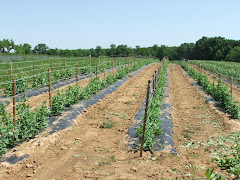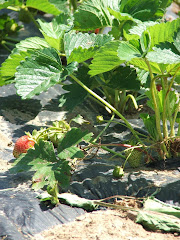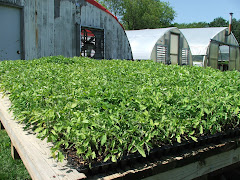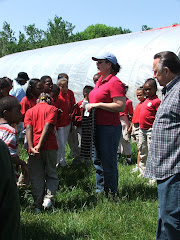Monday, July 20, 2009
Leftover CSA Produce?
Quick and Easy Cabbage Soup
3 cups vegetable broth
2 cloves garlic, minced
2 15-oz. cans of pre-seasoned diced tomatoes (Italian or Mexican)
½ - 1 head cabbage, coarsely chopped
1 medium onion, chopped
1 cup carrot, chopped
½ cup zucchini, chopped (optional)
Basil and oregano, to taste
Salt and pepper, to taste
Directions: Add all ingredients to a large dutch oven or soup pot. Bring to a boil, cover, and simmer on low heat until all ingredients are cooked thoroughly and cabbage is transparent. Season to taste. For a spicier soup, add some diced chilies or jalapeno salt.
Sautéed Collard Greens and Cabbage
3 tablespoons extra virgin olive oil
1 medium onion, sliced
2 tsp crushed chili flakes, optional
2 cloves garlic, minced
¼ - ½ a head of cabbage (depending on the size of the head), sliced
1 bunch (about ½ a pound) of collard greens, center stem removed, sliced
Salt and pepper, to taste
1 tablespoon lemon juice, optional
Directions: Heat the olive oil over medium heat in a large skillet or wok. Add the sliced onion and crushed chili flakes if using, and sauté for a few minutes until they begin to soften and lose color. Add the minced garlic, salt and pepper, and continue to sauté until the garlic becomes fragrant. Stir frequently so the garlic does not burn. Once the onions are translucent and the garlic fragrant, add the sliced cabbage and greens. Frequently toss with tongs to coat cabbage and greens in oil, and to thoroughly cook all ingredients. The greens will first turn a fluorescent green, and then become steadily darker as they cook. Add more salt and pepper to taste. The dish is complete when cabbage is transparent, collard greens are a dark green color, and both are fully wilted. If using, add lemon juice right before removing from pan and serving – if added too early on, it can make the greens lose their vibrant green color.
Sautéed Greens and Mushrooms with Balsamic Vinegar
2 tablespoons extra virgin olive oil
1 red onion, thinly sliced
2 cloves garlic, crushed and finely chopped
2 portabella mushroom caps, cleaned* and cut into ¼ inch slices, OR 1 cup button mushrooms, cleaned* and sliced
½ tablespoon chopped rosemary
1 tsp cayenne pepper
1 bunch (approx. ½ a pound) of collard greens, kale, chard, or any other dark leafy green that holds up well to cooking and heat (not spinach), thick center stem removed, sliced or coarsely chopped
2 tsp sea salt
Pepper, to taste
¼ cup balsamic vinegar or Marsala cooking wine
Directions: Heat the oil in a large skillet over medium heat. Add the sliced onion, and cook for a few minutes until they begin to soften and lose color. Add the garlic and cook about a minute more, until fragrant. Add the mushrooms, rosemary and cayenne pepper. Continue cooking until mushrooms are tender, stirring frequently. De-glaze the skillet with the balsamic vinegar or Marsala wine, and cook about a minute more. Add the greens, sea salt** and pepper to taste. Toss the greens frequently to cook thoroughly. The dish is done when the greens are fully wilted and darker in color.
*To clean mushrooms, do not rinse in water. Take a dry, clean paper towel and gently rub any remaining dirt off of the caps and stems.
**As a general rule, do not add salt to mushrooms until they are almost fully cooked, as salt will promote dryness and much faster cooking when added to raw mushrooms.
Recipe for New Potatoes

New potatoes, although given a special name, are nothing more than young versions of potatoes of any variety. They are picked before reaching full maturity, thus giving them the thin, flaky skin and enhanced taste for which they are known. So what exactly causes these traits? Potatoes that are picked at a younger age have less time to develop a tough skin or process a lot of their sugars into carbohydrates. This leaves you with a delicate layer of skin that never has to be peeled, and a much more heightened, sweeter overall flavor - and for those of you watching your carb intake, less of those too!

While you can easily replace potatoes with new potatoes in any of your recipes, I think it's fun to also explore the more delicate side of the new potato to bring out its unique personality and flavor. The recipe below pairs new potatoes with shallots. Shallots are related to onions and have a reminiscent flavor, but are much more mild and sweet. These qualities will bring out the sweetness of the new potato without overpowering it as a red or white onion might. I have tried this recipe with normal potatoes and onions though, and it is still delicious - so please, use whatever you have on hand, this is a very fun and simple dish to make! Enjoy!
Crunchy New Potatoes with Sautéed Shallots and Fresh Herbs
8-10 new potatoes, scrubbed
4 tablespoons unsalted butter
1 medium-sized shallot, thinly sliced
Salt and pepper, to taste
Fresh basil, oregano, thyme (whatever you have on hand) chopped, to taste
Directions: Melt butter in a heavy-bottomed saucepan. Leave smaller (1 – 1 1/2 inches in diameter) potatoes whole, while halving or quartering larger potatoes. Place the potatoes in the saucepan and cover. Cook on medium heat for 15-20 minutes, shaking the pot occasionally to keep the potatoes from sticking to the bottom. Add the sliced shallot, salt, pepper, and chopped fresh herbs. Recover and cook until shallots are translucent and potatoes tender and golden brown, shaking the pot now and then to distribute herbs and thoroughly cook the potatoes.
Friday, July 17, 2009
Stuffed Patty Pan Squash Recipe
 Patty Pan Squash
Patty Pan SquashSummer squash varieties are versatile vegetables that make excellent side or main dishes in any meal. Patty pan squash, though it may seem dauntingly unusual in appearance, is no exception and can be treated like any other squash. Because of its mild flavor and diverse cooking options, squash can truly help you discover your inner gourmet chef!
For storage, keep all squash in a sealed plastic bag in the refrigerator – most squash will last this way for at least a week or more. When cleaning, rinse the squash in cool water and gently scrub excess dirt off of its skin. Like the potato, many of the squash’s best nutrients are in its skin, so don’t peel! The skin is full of the essential nutrient beta-carotene, while the inner squash is not (although patty pan squash as a whole contains magnesium, niacin, and vitamins A and C).
Most squash can be used interchangeably in recipes, so don’t hesitate to substitute patty pans into your favorite squash recipes. Squash is excellent served raw as crudités or grated or sliced on salads, steamed, baked or roasted, sautéed or fried in oil, grilled, marinated or on kebabs with other vegetables. You can add it to any stir fry, steamed with rice, or diced into soups.
Most herbs and flavors can be paired with squash. Enjoy it with garlic, basil, lemon, dill, or even some chili flakes. Squash also marinates well, so next time you’re grilling or roasting some veggies, throw it in to your favorite marinade for a few hours and you’re good to go.
Patty pan squash is so beautiful and unique in its whole form that it’s almost a shame to cut it into pieces - stuffing it maintains its natural glamor while still allowing for creativity and loads of flavor. Follow the links below to the CSA recipe blog for stuffed patty pan squash and other recipes - but remember to be creative! Experiment with whatever flavors and ingredients you enjoy, and you won’t be
 disappointed.
disappointed.Stuffed Patty Pan Squash
6-8 patty pan squash
2 tablespoons extra virgin olive oil
2 cloves garlic, minced
½ cup onion, finely diced
1 ½ cups soft bread crumbs
Parmesan cheese, grated, to taste (optional
Salt and pepper, to taste
Directions: Preheat the oven to 350° F. To cook squash: Bring an inch of water to boil in a saucepan, add the squash and cover. Cook until stems are tender, about 10 minutes. Remove from water, slice the tops off of the squash, and slice a little off the bottom so the squash can stand up straight on its own. Remove the pulp of the squash with a melon-baller or small spoon and set aside.
To make stuffing: Heat the olive oil in a skillet and add the diced onion. Sauté 5-7 minutes, until soft and translucent. Add the garlic and sauté about a minute more, until fragrant. Add the squash pulp, cooking for another minute or two. Take the skillet off the heat and add the bread crumbs, stirring thoroughly. Add the parmesan cheese, salt, and pepper to taste.
Stuffing the squash: Spoon the mixture into each hollowed squash, filling until overflowing. Cover loosely with aluminum foil, and place stuffed squash in the preheated oven for about 15 minutes, or until everything is heated through. Place the tops of the squash back on top of the stuffing and serve.
Enjoy!!!
Wednesday, June 17, 2009
Garlic Scapes! (or tails, tops, what have you)
 Garlic Scapes, or however else you call them, are the tops of the garlic plant, which need to be cut to promote bulb growth mid-season. Many people are unfamiliar with this delicious and fresh, milder form of garlic, but they happen to be perhaps my favorite vegetable and I hope people enjoy experimenting with them in this weeks' CSA share. They are incredibly tender after only a few minutes of cooking, and pack all the nutrients found in garlic. So here are some scape tips:
Garlic Scapes, or however else you call them, are the tops of the garlic plant, which need to be cut to promote bulb growth mid-season. Many people are unfamiliar with this delicious and fresh, milder form of garlic, but they happen to be perhaps my favorite vegetable and I hope people enjoy experimenting with them in this weeks' CSA share. They are incredibly tender after only a few minutes of cooking, and pack all the nutrients found in garlic. So here are some scape tips:In a salad:
Chop them up and throw them in a salad, they'll add a garlicky punch that is really nice for garlic fans-it isn't as strong as real garlic, so don't worry. I haven't done this, but something tells me they would be great in a salad niçoise.
Sauteed:
Cut off the tough ends and tops of the flower tips of your scapes and sautee in butter or olive oil; I've done this with a tablespoon or two of brown or white sugar (caramalize the sugar briefly in the oil, then add the scapes) or with soy sauce- or both- with excellent results. Scapes only need a few minute
 s of cooking.
s of cooking.Thai Coconut Curry with Garlic Scapes:
Lots of people have a recipe for something like this, and the garlic scapes would work just as well in a stir-fry. Treat the scapes like scallions and chop them up and throw them in with the onion. I made a coconut curry with some friends last night which had coconut milk, lemon grass, ginger, garlic scapes, onion, purple cabbage, carrot, chilis, green peppers and tofu. And yes, it was very good. Just remember to use an oil with a high heat point (peanut oil is good) so you can cook it fast and hot.
And last but not least: Pickled Garlic Scapes!
Yes, that is right, pickled garlic scapes! Exclamation points are necessary because these are just so good, and let you enjoy scapes all through the winter. Pickle them as you would to make dilly beans or pickles (but extra garlic is unnecessary).

photo credits: Patti Truant, Christiana Usenza
Monday, June 15, 2009
Keeping produce fresh
Countless CSA members have praised the freshness and flavor of local organic produce. From my own experience, the first time I enjoyed fresh corn from Maryland's own One Straw Farm, the taste and texture were so rich and flavorful that I felt as though I was eating an entirely novel and unfamiliar food. Conventionally grown crops, in contrast, are typically bred (either via hybridization or transgenic lab technology) for long-shelf lives, uniform size, pest resistance and durability over long and bumpy transport. As a result, conventional produce is often comparatively bland.
You may find that fresh organic produce spoils a bit earlier than their conventional counterparts. To preserve freshness and convenience, wash and store your greens as soon as you get home. Consuming them earlier in the week will minimize nutrient loss over time.
Some CSA members have endorsed GreenBags, which reportedly prolong freshness. I haven't yet tried them myself, but anything to minimize food waste is probably a worthwhile venture.
Discarded organic material heads to a landfill, where the decomposition process releases methane, a potent greenhouse gas. If you find yourself discarding organic material and you don't have a composting system of your own, you can bring it with you the next time you head to Whole Foods by the harbor, where you can drop it off in a compost bin (no sense making a special trip to drop it off, lest you negate the environmental benefits by driving). Storing it in the freezer works well (frozen compost, I know, sounds weird - but it won't smell or attract insects, and a full fridge/freezer actually uses less energy).
Recommended resource: How to keep your vegetables fresh
Wednesday, June 10, 2009
Thai Lettuce Wraps
You may be wondering, if 'food miles' aren't a major issue, why sign up for a CSA? This is a broader topic that I'll address in subsequent blog entries, but safe to say there are substantial benefits of CSAs that go beyond mileage.
Returning to the topic at hand - lettuce wraps - here's a crispy, high-protein treat that's perfect on a hot summer evening. Since I more or less threw this together on a whim, let's dispense with formal measurements:
- Lettuce leaves (washed)
- Peanuts
- Peanut sauce (prepared or homemade)
- Extra firm tofu
- Brown rice (cooked)
- Garlic, chopped
- Chili pepper, chopped
- Cilantro
- Olive oil
- Lime/lemon juice
Tofu prep: Tofu, straight of the box, tends to be a bit watery. For a chewier texture, cut a package of tofu into cubes, apply light pressure (not so much that you mash it into soymilk) to drain off water, then place them in the freezer. When ready to use, thaw, apply pressure and drain additional water.
Sautee the garlic and chili in olive oil. Add peanuts, tofu and peanut sauce. Cook until tofu is browned.
Remove spines from lettuce (the crunchy parts don't wrap very well). Wrap tofu mixture, cilantro, brown rice and a dash of lemon. Dip in peanut sauce.
When wraps inevitably fall apart, resort to fork.
Tuesday, October 28, 2008
a great recipe for spaghetti squash
Gingered Spaghetti Squash:
1 small spaghetti squash cut in half, deseeded
2 tablespoons butter
1 tablespoon honey
1/2 tablespoon minced ginger
Salt and black pepper
Pre-heat oven to 375 degrees. Place squash on baking dish and add the butter, honey, ginger and seasoning. Bake for 45 to 60 minutes until squash is "al dente". Do not overcook the squash. Spoon out squash and check for seasoning. Keep warm for serving





